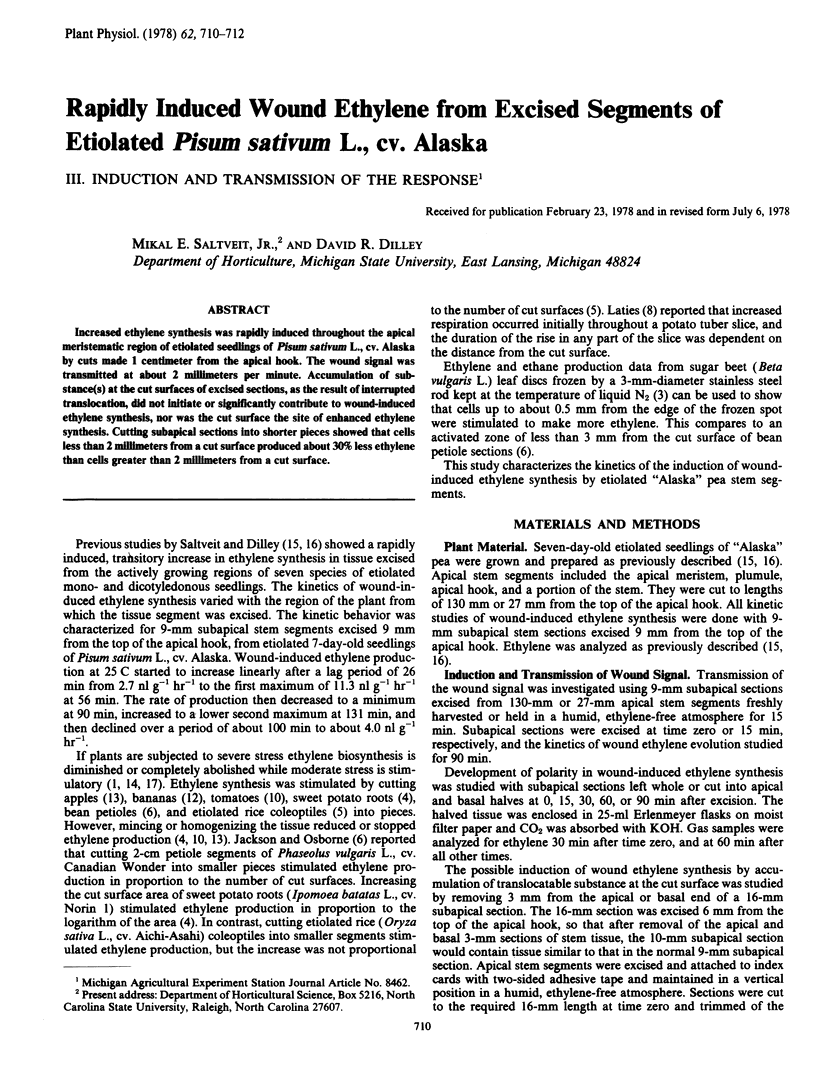Abstract
Increased ethylene synthesis was rapidly induced throughout the apical meristematic region of etiolated seedlings of Pisum sativum L., cv. Alaska by cuts made 1 centimeter from the apical hook. The wound signal was transmitted at about 2 millimeters per minute. Accumulation of substance(s) at the cut surfaces of excised sections, as the result of interrupted translocation, did not initiate or significantly contribute to wound-induced ethylene synthesis, nor was the cut surface the site of enhanced ethylene synthesis. Cutting subapical sections into shorter pieces showed that cells less than 2 millimeters from a cut surface produced about 30% less ethylene than cells greater than 2 millimeters from a cut surface.
Full text
PDF


Selected References
These references are in PubMed. This may not be the complete list of references from this article.
- Bush K. J., Sweeney B. M. The Activity of Ribulose Diphosphate Carboxylase in Extracts of Gonyaulax polyedra in the Day and the Night Phases of the Circadian Rhythm of Photosynthesis. Plant Physiol. 1972 Oct;50(4):446–451. doi: 10.1104/pp.50.4.446. [DOI] [PMC free article] [PubMed] [Google Scholar]
- Imaseki H., Pjon C. J., Furuya M. Phytochrome Action in Oryza sativa L: IV. Red and Far Red Reversible Effect on the Production of Ethylene in Excised Coleoptiles. Plant Physiol. 1971 Sep;48(3):241–244. doi: 10.1104/pp.48.3.241. [DOI] [PMC free article] [PubMed] [Google Scholar]
- Jackson M. B., Osborne D. J. Ethylene, the natural regulator of leaf abscission. Nature. 1970 Mar 14;225(5237):1019–1022. doi: 10.1038/2251019a0. [DOI] [PubMed] [Google Scholar]
- Laties G. G. Controlling Influence of Thickness on Development & Type of Respiratory Activity in Potato Slices. Plant Physiol. 1962 Sep;37(5):679–690. doi: 10.1104/pp.37.5.679. [DOI] [PMC free article] [PubMed] [Google Scholar]
- Macklon A. E., Higinbotham N. Electropotential in excised pea epicotyls. Plant Physiol. 1968 Jun;43(6):888–892. doi: 10.1104/pp.43.6.888. [DOI] [PMC free article] [PubMed] [Google Scholar]
- Nakagaki Y., Hirai T., Stahmann M. A. Ethylene production by detached leaves infected with tobacco mosaic virus. Virology. 1970 Jan;40(1):1–9. doi: 10.1016/0042-6822(70)90372-7. [DOI] [PubMed] [Google Scholar]
- Saltveit M. E., Dilley D. R. Rapidly Induced Wound Ethylene from Excised Segments of Etiolated Pisum sativum L., cv. Alaska: I. Characterization of the Response. Plant Physiol. 1978 Mar;61(3):447–450. doi: 10.1104/pp.61.3.447. [DOI] [PMC free article] [PubMed] [Google Scholar]
- Saltveit M. E., Dilley D. R. Rapidly Induced Wound Ethylene from Excised Segments of Etiolated Pisum sativum L., cv. Alaska: II. Oxygen and Temperature Dependency. Plant Physiol. 1978 Apr;61(4):675–679. doi: 10.1104/pp.61.4.675. [DOI] [PMC free article] [PubMed] [Google Scholar]


